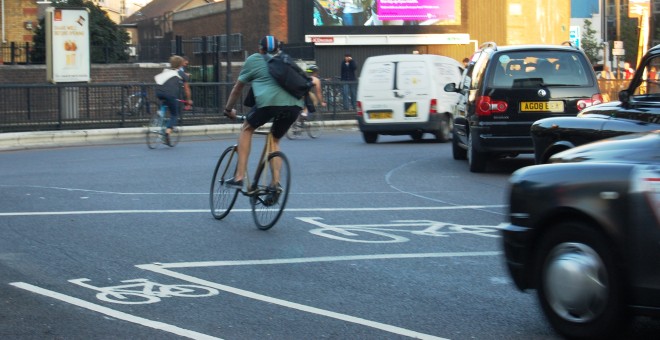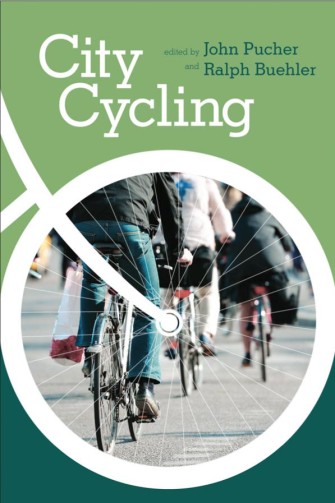
Cycling Because It’s Faster: How Long Does Your Commute Really Take You?
Many cyclists already know they are faster than cars, particularly in peak hour traffic. Yet even cyclists may be surprised at how much time bicycles can save in any city when all time costs are considered. Dr. Paul Tranter, who has written a chapter in the upcoming "City Cycling" book, tells us why.
You may already know it, but in most cities throughout the world, cycling is a “faster” mode of transportation than the car. But for those that still aren't convinced, it's time to learn about “effective speed”.
About “City Cycling”
City Cycling has just about everything you can imagine in it when it comes to cycling. It's a must read for anybody working in the field or transport and for bicycle advocates, it's going to be the bible.
“City Cycling”appears in print in September but can already be ordered at a pre-publication discount ($18) at Amazon and Barnes and Noble.
For further information about the book, including a detailed table of contents and listing of contributors, see the following website.
"Effective speed is calculated using the standard formula: speed equals distance divided by time. Time here includes not only the time spent moving; it also includes the time devoted to enabling the movement to occur," explains Dr. Paul Tranter, a geography Professor at the University of New South Wales, and an author from the upcoming City Cycling book.
"For car drivers, a significant (and usually ignored) time cost is the time spent at work to earn the money to pay for all the expenses associated with the mode of transport."
And he's right. All too often, car drivers rarely consider the total time devoted to their machines. If you're not convinced, here's a little anecdote that Tranter tells to make to change your mind:
Imagine that you live in a village in the 1800s and that your job each day is to collect water from a nearby stream. This task takes you an hour each day. To “save time,” you construct a machine consisting of a system of pulleys, cables, levers, and springs to collect the water for you. With this machine, simply by pulling a lever, you can send your bucket to the stream and have it returned full of water. You appear to have saved yourself an hour each day. However, to get the machine to work, you must spend an hour each day winding up the spring that powers the machine. Should you consider this time in any decision about the effectiveness of the machine?
"Many motorists—and city governments—seem to ignore this time spent earning money to pay for the transportation costs, that is, the time spent winding up the spring,” explains Tranter.
We shouldn't forget this concept of effective speed is nothing new. Ivan Ilich, in his 1974 book "Energy and Equity" outlined it perfectly:
"The typical American male devotes more than 1,600 hours a year to his car. He sits in it while it goes and while it stands idling. He spends four of his sixteen waking hours on the road or gathering his resources for it. … The model American puts in 1,600 hours to get 7,500 miles: less than five miles per hour.”
How fast is your city?
Tranter, in the upcoming “City Cycling” book, has gone to the trouble to finding just how fast cars really by crunching data on income and travel times. The results almost beggar belief.
Effective speeds for car speeds varied from 18.3 km/h in Canberra, Australia, to a mere 3 km/h in Nairobi. When the external costs are taken into account, the effective speeds for car drivers range from a high of 15.9 km/h (Canberra) to a low of 2.2 km/h (Nairobi).
"We then used these estimates to calculate how slow cyclists could cycle and still be effectively faster than a car. When both direct and indirect costs are considered, cyclists in Canberra would need to average only 18.3 km/h to be faster than a car driver. In New York, Los Angeles, Tokyo, and Hamburg, cyclists would not need to travel faster than 13 km/h to be faster than a car," says Tranter, before adding:
"To be effectively faster than the number-one-selling car in Australia, a cyclist in Canberra would need to cycle at only 12.7 km/h. In all other Australian cities, the cyclists could travel slower than this, and still be faster than the top-selling car."
So what does this mean for governments?
If city governments wish to invest wisely in transportation, they need to understand that increasing the average trip speeds of private motor vehicles doesn't actually save time. This argument applies to any city in the world.
"Those cities that invest most effectively in cycling infrastructure will find that their cities become the fastest cities in the world," says Tranter.
Thankfully, when we're on a bicycle we don't always have to rush. Taking it slowly is part of the fun. But we can still feel smug as cars go past knowing who's really the fasted.
Want to read more? Make sure you check out our City Cycling series with John Pucher and Ralph Buehler here.
 About The Author
About The Author
Dr. Paul Tranter is an Associate Professor in geography in the School of Physical, Environmental and Mathematical Sciences at the Canberra campus of the University of New South Wales, located in the Australian Defence Force Academy.
Tranter’s research and teaching interests are in the areas of transport geography, and global change. He has made a pioneering contribution to the areas of child-friendly environments, active transport, and healthy and sustainable cities within academic literature
Contact the author
Recent news!
Upcoming events
Contact Us
Avenue des Arts, 7-8
Postal address: Rue de la Charité, 22
1210 Brussels, Belgium











